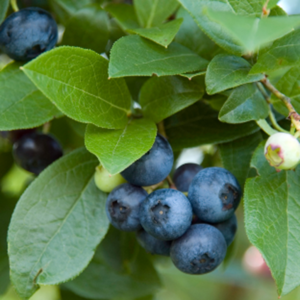By Kathy Torres
 Blueberries are often labeled a “superfood” because they are loaded with vitamins and minerals. The deep blue color comes from anthocyanin, an antioxidant that can help protect the body from heart disease and cancer, reduce inflammation and increase immune function. Research also suggests the compounds found in blueberries may boost brain health, lower blood sugar levels, and improve insulin sensitivity. A half cup of blueberries a day just might be what the doctor ordered! Wouldn’t it be great to rely on your own backyard blueberry bushes to provide them? Did I mention they are also low in calories?
Blueberries are often labeled a “superfood” because they are loaded with vitamins and minerals. The deep blue color comes from anthocyanin, an antioxidant that can help protect the body from heart disease and cancer, reduce inflammation and increase immune function. Research also suggests the compounds found in blueberries may boost brain health, lower blood sugar levels, and improve insulin sensitivity. A half cup of blueberries a day just might be what the doctor ordered! Wouldn’t it be great to rely on your own backyard blueberry bushes to provide them? Did I mention they are also low in calories?
There are four types of blueberry plants: Northern Highbush, Southern Highbush, Rabbiteye, and Lowbush. Rabbiteye varieties are hardiest in the south, producing sweet fruit with high yields of large berries, and are not problematic with regard to diseases and pests. Various cultivars are available, including Brightwell, Climax, Delite, Pink Lemonade, Powderblue, Premiere, and Tift Blue. Pink Lemonade is the smallest, with a maximum height of 4.5 ft. Brightwell and Delite can reach 10 ft. tall, and the others will mature at about 6.5 ft.
Rabbiteye blueberry bushes can be grown successfully in a sunny spot and they prefer acidic soil. It’s a good idea to test the soil to determine the pH, which should be between 4.0 to 5.3. This is lower than many plants will tolerate, even camellias and azaleas. If soil test results show your soil pH is over 5.5, you may need to apply aluminum sulfate or sulfur to the soil. Stop by one of our Wingard’s checkout stations and we can provide a soil sample bag and process the paperwork and payment to Clemson Extension for you. Check out this Clemson Extension fact sheet for more information on changing soil pH. FACT SHEET
 Blueberries grow best in well-drained soil that has plenty of organic matter. We recommend Stout Ollie, a mixture of three different organic composts. If you have heavy clay soil or poor drainage, amend the soil by mixing in soil conditioner (finely ground pine bark). Mounding the soil 6”-12” high and 2’-3’ wide is another way to improve drainage in clay soil. Keep plants adequately watered, especially during the first few years while they become established. Blueberry bushes can retract water from berries during fruit production, so it is essential for the plant to receive adequate water through the roots in order to produce plump, juicy berries. Next year’s buds are set in late summer and early fall, another reason they must receive adequate moisture. Add mulch to help retain moisture and reduce weeds.
Blueberries grow best in well-drained soil that has plenty of organic matter. We recommend Stout Ollie, a mixture of three different organic composts. If you have heavy clay soil or poor drainage, amend the soil by mixing in soil conditioner (finely ground pine bark). Mounding the soil 6”-12” high and 2’-3’ wide is another way to improve drainage in clay soil. Keep plants adequately watered, especially during the first few years while they become established. Blueberry bushes can retract water from berries during fruit production, so it is essential for the plant to receive adequate water through the roots in order to produce plump, juicy berries. Next year’s buds are set in late summer and early fall, another reason they must receive adequate moisture. Add mulch to help retain moisture and reduce weeds.
Although fall is the absolute best time to plant, inventory in garden centers is plentiful in the spring and the chances of finding varieties you want are better. As long as you are diligent about watering in the heat of summer, you will be OK. Be sure to plant at least two different varieties for cross-pollination to occur. This will bring you the best yield of berries.
It will be painful for you, but cut off the blooms that appear in the first spring. Not producing fruit will put the plant’s energy into root and stem growth, which will make it bigger and healthier the next spring. Rabbiteye blueberry bushes, during the first five years, require very little pruning. During dormancy (Dec-Mar), remove lower, twiggy growth, dead shoots and spindly growth. Cut back excessively long shoots to stimulate lateral branching and to thicken the shoots.
Mature plants require more dramatic pruning to maintain health and ensure maximum yield. Generally, remove all but seven canes, eliminating the oldest or largest canes. Selective cuts should be made to open up the center of the plant to allow light penetration and discourage disease. Pruning of older plants should take place immediately after harvest.
 Do not fertilize blueberry bushes when first planted. Wait until the following spring. From that point, fertilizer should be applied twice a year. Apply Holly-tone when spring growth begins and again in June. Do not use nitrate forms of fertilizer for blueberries as this will cause root damage.
Do not fertilize blueberry bushes when first planted. Wait until the following spring. From that point, fertilizer should be applied twice a year. Apply Holly-tone when spring growth begins and again in June. Do not use nitrate forms of fertilizer for blueberries as this will cause root damage.
We often have a late freeze or two in spring that can harm blooms or young fruit, so pay attention to the freeze warnings and cover the plant with an old sheet. Anchor it down if it’s windy.
Your first harvest will be in late May or early June. Wait until the berries are plump and deep blue. Let them sit out a few days after you pick and they will become sweeter. You will harvest several times as the berries ripen. Be prepared to lose a few to the birds that visit your yard, however, netting is available to cover the plant and discourage the birds, if you’d rather not share.
One of the most enjoyable treats of early summer is fresh picked blueberries. A nutritious snack to eat just as they are, or mixed into delicious pies, cakes, and muffins. Click on this link for one of my favorite Blueberry Muffin recipes. To Die For Blueberry Muffins Recipe | Allrecipes Try them and it’s highly likely you’ll want to plant your own blueberry garden!

